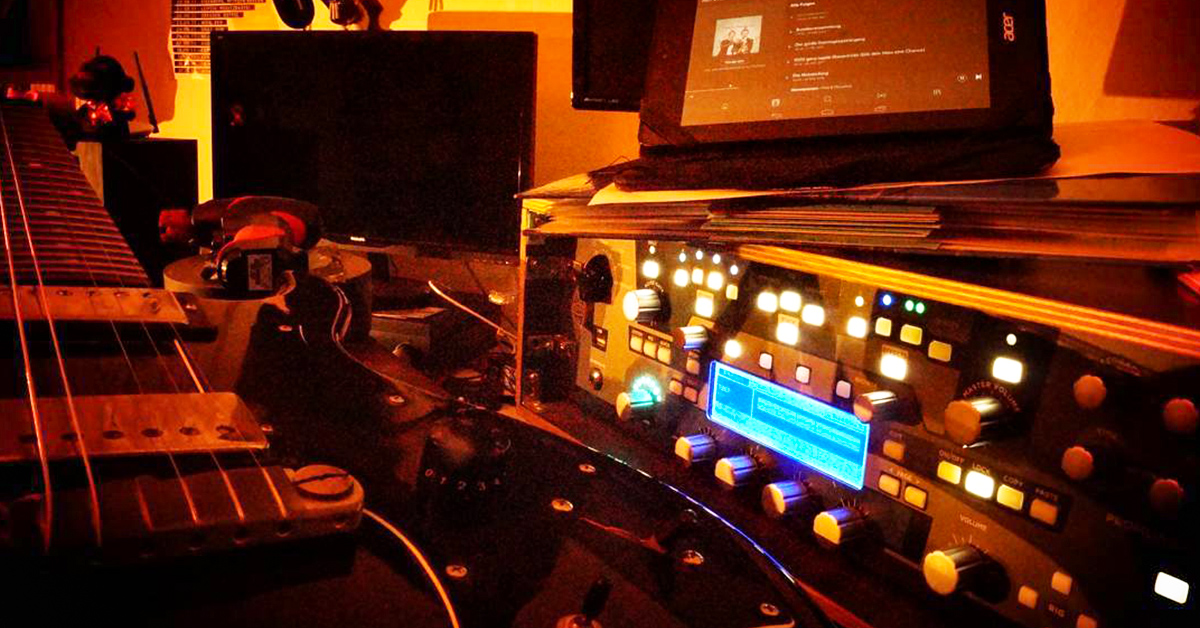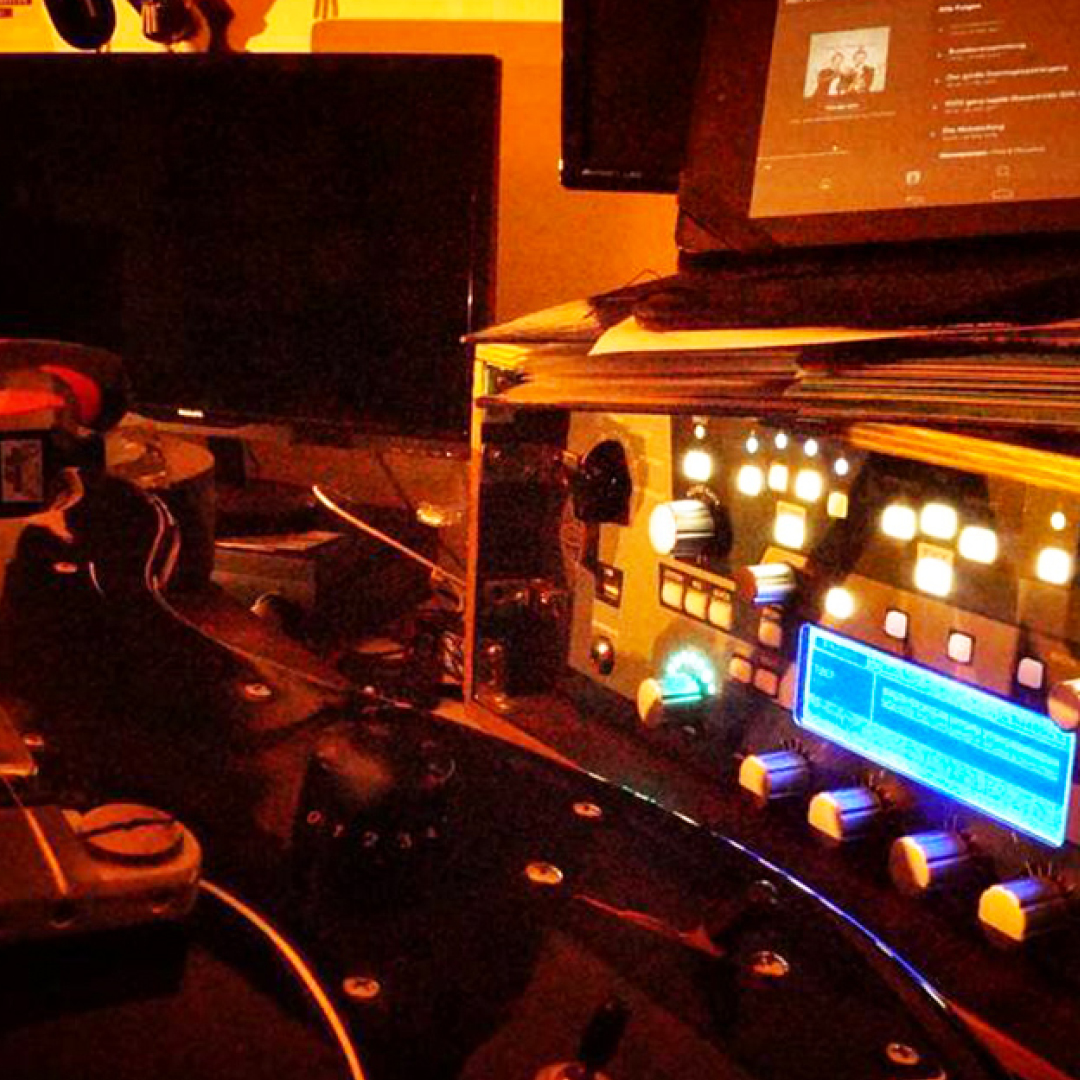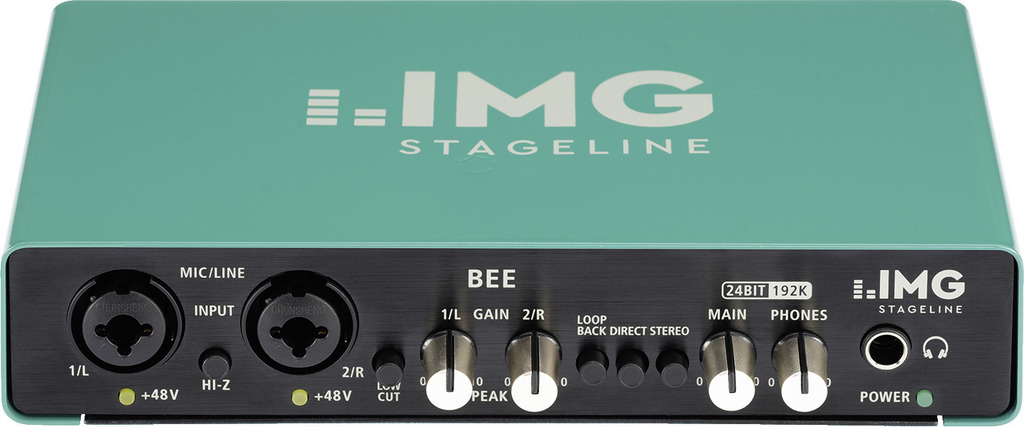
RECORD YOUR OWN MUSIC? JUST DO IT!
Two easy ways to record your own music
The BEE is an easy-to-connect 2-channel USB recording interface
It is the ideal choice for musicians, mixing engineers, sound designers and…
Recording equipment is available at an attractive price nowadays and almost everyone has got a PC in the rehearsal room. The artistic variety as well as the originality of many artists can greatly benefit from that because it means more DIY for everyone. While expensive recording studios in particular can capture every little sound nuance and carry out their loudness war, bands have ever-improving possibilities to record their own songs. A plea for more courage to DIY, more precisely: to record your own music.
The first rehearsal room: have more courage to REC'n'Rock!
Probably the easiest way to record your own songs: recording in your rehearsal room. Just put a microphone in the rehearsal room and use a cheap recording interface, nowadays you can get one for less than 100 Euros.. You can then play your songs and edit the material with an appropriate program. That is all there is to it.
If you mount the microphone at ear level, the signal will arrive as you hear it.
Either place your mic in an upright position in the room or let it dangle from the ceiling, you will think of something. There are also recording bundles that can get you started directly.
Recording your own song helps the band in two ways: first of all, we hear our own songs differently when we sit on a couch and listen to our music for the first time using monitor speakers or headphones. It is a feeling of deepest joy: we have thought it up, written it and recorded it. It is a huge motivation to keep going. Tommy Newton (producer and FOH) and Tammo Reckeweg (singer and guitarist with the band LENNA) see this as the first opportunity for their own personal growth:
Tommy Newton, former guitarist of Victory and
cult producer
From my point of view, one of the first steps for young bands: record a song in the rehearsal room and leave it there for a week. Then, listen to it again.
Otherwise you often do not see the wood for the trees, especially with your own songs.
If you listen to your rehearsal room recording again somewhat later, you may notice one or two blunders, either in the game or in the arrangement. However, a demo which you send to promoters and labels as an application is a completely different matter.
Tammo Reckeweg, guitarist and singer with the band
LENNA
This also applies to performances. It is essential to film or record the audio track if possible. Not in order to publish any of it but to see afterwards how your performance went. If you watch or listen to your performance a day later, you will notice things that you could not have noticed while playing live, for example a clumsy bridge or playing a wrong note. From my point of view, it can never be early enough for bands to start recording themselves. We record a live audio track from each rehearsal in which we are playing new songs. Me or our bass player then sit down in the evening to cut it and listen to it all over again.
You will need the following things for a demo in your rehearsal room:
For a rehearsal room recording, you will not need much more than your instruments and amps:
- A computer
- An interface with phantom power
- A proper condenser microphone
- A DAW software: Digital Audio Workstation. There is good freeware available in this field.
Alternatively, there are USB microphones which you can use to record directly onto your computer: Just plug it in and go.
However, an interface offers additional elements. There are very cheap interfaces that can easily record your complete sound from the rehearsal room with one input.
Attention: The maximum sound pressure must not be too high for the room mic during recording.
Therefore, it is advisable to measure the volume level of the whole band in your rehearsal room. There are audio tools which are easy to transport and can reliably measure the volume. Otherwise, you can record your songs 'live' in the rehearsal room.
A tip from rapper Kesh is to record the vocals after the instruments:
Max „Kesh“ Meißner,
rapper
Vocals are a difficult thing. They do not work on a 'dirt track' (a rough on-the-fly pre-recording) or on midi tracks. So what you cannot do is pre-record with a drum computer and midi instruments on your PC, then sing or add rapping and in the third step have musicians record the rhythm section or melody. You can forget that because the voice is very closely meshed with the rest. It always sounds a little 'off'. Instrumentalists have their own groove, midi tracks do not. You want to use instrumentalists for your tracks? Then the vocals will have to wait.
A rehearsal room demo, but fatter: miking, mixing, thrilling multi-sound!
'Thrilling multi-sound', noun, feminine, spoken meːɐ̯-saʊ̯nt-ˈfʁɔɪ̯də, describes the musician's joy about a fatter sound. How does that work? Record the instruments one by one and then insert them. This is, of course, also possible with the setup from above: you take the USB microphone and place it behind the various speakers. However, not every microphone is equally suitable for overhead, bass drum, stringed instruments and vocals, i.e. no microphone can do everything equally well.
To make sure you do not start from scratch when recording the individual tracks, you record a 'dirt track' which then serves as a basis and orientation for the individual instrumentalists. It is best to let a metronome run along via your headphones.
You will need the following for a fat rehearsal room demo with a 'thrilling multi-sound':
- A computer
- Either a two-channel interface or, if you value a well-mixed drum sound, a 12-channel mixer
- A low-noise and highly detailed condenser microphone
- At least one overhead microphone
- A microphone for the bass drum. The bass drum can already have a sound pressure of 140 dB, the microphone must be able to withstand this
- A DAW software
With the condenser microphone you are recording instruments, except drums and percussion. If you have two condenser microphones, you can also record stereo. Thus, it provides a higher flexibility. The overheads and the microphone which feature the highest sound pressure will be used for drums.
If you use a dynamic microphone with supercardioid polar pattern, you can use the same microphone for bass drum and vocals. This might feel weird, because dual-use has not been possible in the past. With good microphones, this is no longer a problem nowadays.
The best thing about this setup: with one or two more condenser microphones and a good vocal microphone you will have a solid live miking, too. According to Sebastian Dracu, you should, however, not go overboard:
Sebastian Dracu,
guitarist and singer
For me, as 'raw' as possible is still the best thing that can happen during recording. Autotune, midi sounds, etc. You can just keep it. Sound source, microphones and rock'n'roll are my requirements and I will not change it. I am all for experimenting with analogue: large diaphragm microphones are quite demanding, they have to be perfectly placed. The same applies to positioning dynamic microphones at the amp. Every angle and every setting changes the sound. You should try out a lot. You will then know intuitively how to fully utilise them.
Use your home advantage with home recording!
Of course, the above setup still leaves room for improvement. A microphone preamplifier gives you more powerful vocals; a DI box ensures a perfect sound transmission between the recording microphone and the mixer. You can also improve acoustics in the rehearsal room. Play around with the setup and discover new sound nuances. Sooner or later you will notice some background noise. These are often a mixture of a high input or external influences. Janosch Held tells you here how to get to the bottom of background noise.
Special case drums: a separate mixing project
Drumming is all about quantity: use more microphones, but cheap ones. More microphones mean: more control and more power. Sebastian Dracu uses a setup with a total of 10 sound sources, perfectly suitable for a medium-sized mixer.
"I pick up the sound of the drums as follows: two overheads, three toms, two before the kick, two on the snare, sometimes one on the hi-hat."
— Sebastian Dracu, winner of the Rock&Pop Award 2016 in the category 'Best Drummer'
If you like to experiment, you can play around with some effects on a digital mixer. A compressor often works wonders on the bass drum. Just try it out. In the digital age, recording does not cost anything, you are not wasting any tapes. You can lock yourself in at home or in the rehearsal room, order pizza and record, optimise the sound or just jam all night long.
Photos © The Hirsch Effekt

